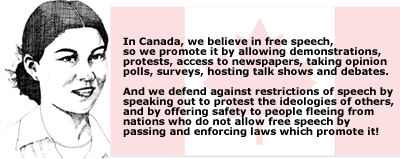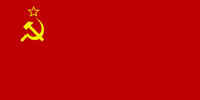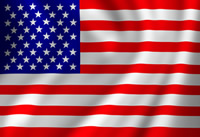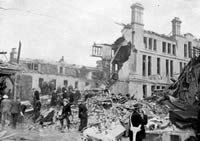Lesson Five: Promoting and Defending Against Ideologies
| Site: | MoodleHUB.ca 🍁 |
| Course: | Social 30-2 RVS |
| Book: | Lesson Five: Promoting and Defending Against Ideologies |
| Printed by: | Guest user |
| Date: | Monday, 27 October 2025, 8:19 AM |
1. Introduction
Promoting and Defending Ideologies
Issue Question: Is resistance to liberalism justified?
- appreciate how citizens and citizenship are affected by the promotion of ideological principle
- appreciate that individuals and groups may adhere to various ideologies
- examine how ideological conflict shaped international relations after World War II
- evaluate the extent to which resistance to liberalism is justified
Duration: 2 blocks (80 mins each + homework)
In this lesson you will learn that competing ideologies produce conflict. This was particularly evident during the Cold War, ranging from 1947-1991. The Cold War was a period of geopolitical tension between the Soviet Union and its satellite states, and the United States and its allies after World War II. The rivalry lasted for decades and resulted in international incidents that led the two superpowers to the brink of nuclear war.
2
In this lesson you will learn that competing ideologies produce conflict. This was particularly evident during the Cold War, ranging from 1947-1991. The Cold War was a period of geopolitical tension between the Soviet Union and its satellite states, and the United States and its allies after World War II. The rivalry lasted for decades and resulted in international incidents that led the two superpowers to the brink of nuclear war.
2. Lesson 4.5.1 How Nations Interact

|
|
|
Ideologies motivate nations to interact in various ways. The importance of ideologies to nations makes their promotion and defense against other ideologies vital to the existence of the nation. The methods used to promote or defend against ideologies bring various consequences. These consequences, however, all involve changes in relations among nations. Nations must consider three basic types of interaction:
|
Go through this powerpoint to learn more about how nations interact.
3. Lesson 4.5.2 Ideological Differences at the End of World War II
|
The Big Three 1945: (from left to right)
|
In 1945, as it became apparent that the end of World War II was near and an Allied victory was assured, power politics became very important at the final meeting of the Big Three: the United States, Britain, and USSR. To understand further the power politics, consider the perspective of each of the nations attending the final two wartime conferences, the Yalta Conference and the Potsdam Conference.



USSR:
Stalin's primary concern was with Soviet strength and security. During WWI and WWII, the USSR had been devastated by German invasions from the west (not to mention Napoleon's French army invasion in the early 1800s, also from the west). For this reason, Stalin required assurances that this would not happen again. To this end, Stalin wanted a buffer zone, a protective cushion of territory between the west and the Soviet Union. Stalin also had interests in the Far East and wanted to increase Soviet influence in that area also.United States:
The American president, Franklin Roosevelt, did not want the U.S. to fall into a postwar isolationist policy again as it did after WWI. Instead, he believed that the U.S. should take more responsibility in world affairs, primarily in the area of world peace and human rights. Roosevelt had idealistic views of a free and peaceful postwar world. The American economy depended strongly on the world's markets, and Roosevelt did not want another worldwide depression. To protect against this, he wanted to encourage a world of "freer trade" where American ideas and products had access to the world's markets. Roosevelt also recognized Stalin's need for Soviet security, and he wanted to avoid the impression that the US and Britain were "ganging up" on Stalin.Britain:
Winston Churchill was concerned mainly about two things:
the growing strength and influence of the Soviet Union
the declining strength and influence of Great Britain
The Yalta Conference
The Big Three (Churchill, Stalin, and Roosevelt) met for the last time at Yalta in the Crimea (southwestern part of the Soviet Union by the Black Sea) in February 1945. (The next time the Big Three powers met, Churchill and Roosevelt had been replaced.) To understand the significance of this meeting, note the following:
-
Soviet troops were only forty miles from Germany's capital, Berlin. British and American troops were not even in Germany yet. Because the Soviet Red Army occupied much of eastern Europe, Britain and the US could do little about Stalin's claims to eastern Europe.
-
Britain and especially the U.S. were preoccupied with the war against Japan in the Pacific, which the Soviets had not been involved with.
These two points are essential to remember when you consider the Yalta Agreement.
The main terms of the Yalta agreement were as follows:
-
Germany would be divided into four zones of occupation: American, British, French, and Soviet.
-
The Soviet Union would enter the war against Japan after the defeat of Germany.
-
In exchange for the Soviet Union's entrance into the war against Japan, it would receive territorial concessions in the far east: the Sakhalin and Kuril Islands (just north of Japan), certain rights in Manchuria (China), and other territorial privileges in the Far East.
-
In Europe, Poland's boundaries would be altered at Stalin's request. Poland's eastern boundary with the USSR would be given to the USSR as part of Stalin's buffer zone against the west.
-
Poland would be left to choose freely its own government.
The Potsdam Conference
The Potsdam meeting in July 1945 was the last WWII wartime conference, and it introduced two new people. Stalin was joined by Clement Atlee, the new British prime minister, and Harry S. Truman, the new US president. By now the war in Europe was over; Nazi Germany had been defeated. The U.S. was preparing for an invasion of Japan. Britain, similar to the remainder of Europe, was crippled by the war. Soviet troops still occupied much of eastern Europe. The one US advantage was that it had developed a successful atomic bomb that the Americans were planning to use against Japan.
Mistrust had developed between Stalin, a communist totalitarian dictator, and the Western capitalist democracies. Already Stalin was exerting his power and influence in eastern Europe. The British or the Americans seemed unable to do anything about Stalin's expansionism. The Potsdam conference, however, did make some formal agreements although a number of issues were left unresolved. These issues were to be settled at a future meeting, one that never happened.
The Potsdam settlements included the following:
-
Germany was to pay reparations for war damages.
-
Germany was to be de-nazified; all aspects of Hitler's fascism were to be removed.
-
Nazis accused of war crimes would be brought to trial and punished.
-
Final boundaries for the Allied occupation zones of Germany were decided.
-
Poland's borders would be re-drawn.
-
German military and its arms industry would be dismantled.
-
Now that Germany had been defeated, the Soviet Union would join in the war against Japan

n your textbook, Understandings of Ideologies, read "End of the Second World War: Agreements and Ideologies" (including "The Yalta Conference" and "The Potsdam Conference") on pages 186-188. These pages will further your understanding of the concept of ideological conflict with liberalism.
You should make notes, either on paper or on your computer, about what you have read.4. Lesson 4.5.3 Cold War - Ideologies in Conflict

British rescue workers searching through wreckage after bombing
Cold War Introduction
The defeat of Nazi Germany and the end of the World War II had a dramatic effect on the power of most European nations. European countries at the centre of the conflict were crippled physically, militarily, and economically. Although the USSR had lost about 20 million people during the war, it still remained relatively strong, second only to the United States. It was strong enough that history has defined the United States of America and the Union of Soviet Socialist Republics as the only two world superpowers following World War II. The development of nuclear weaponry and the growth of national armies continued to add superpower status to both the United States and the Soviet Union.
The end of World War II introduced a new regime on the world scene. Communism threatened liberal democratic and capitalist ideologies. Allies that had fought side by side during the war became enemies in a new kind of war, a war that was based on ideological differences between communism and capitalism.
During World War II, the USSR and the United States formed an alliance of necessity and joined to defeat fascism. However, when the common enemy had been defeated, old opinions about communism and capitalism resurfaced.

Here is a crash course on the Cold War
For more information on the Cold War: Ideologies in Conflict you can read chapter 8 of Understandings of Ideologies, pages 185-215.
5. Conclusion
Although the Cold War did not officially end until the collapse of the Soviet Union in 1991, ideological differences that led to the split between the East and West continued to soften throughout the 1980's. American and Soviet officials understood that rising tensions could lead to a war that neither side could win. Diplomacy and cross-cultural interactions contributed to a greater understanding of the differences between the two superpowers. Interactions in the post-Cold War era required the United States and the Soviet Union to work together for many reasons, including the lack of a desire to continue to use their resources to stay in a state of conflict with one another. Some observers believe that the political and economic changes made by Gorbachev during his leadership contributed to bringing the Cold War to an end. Others would argue that the Soviet Union was not able to match the spending of the United States during the 1980's, and was somewhat forced into a situation of negotiation with the US given this military gap between them.

US President Ronald Reagan and Soviet Leader Mikhail Gorbachev
